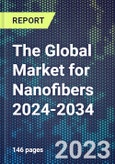The Global Market for Nanofibers 2024-2034 analyzes the global nanofibers industry, providing a comprehensive overview of the market size, growth trends, key players, applications, technologies, and regional markets. Major applications of nanofibers include filtration, tissue engineering scaffolds, wound dressings, drug delivery, sensors, protective clothing, and composites reinforcement.
Report contents include:
- Market growth drivers.
- Analysis of various types of nanofibers, manufacturing methods like electrospinning, and challenges around scaling up production.
- Analysis of major market segments including filtration, textiles, and medical, market drivers, product innovations and key applications, and revenue forecasts by market.
- Regional markets are also explored in detail, with historical and projected nanofiber revenues broken down for North America, Europe, Asia Pacific, and other regions.
- Profiles of 82 companies. Companies profiled include Asahi Kasei, BioSurfaces, LLC, Donaldson, Enerol Nanotechnologies, Gelatex Technologies OÜ, IDKLAB, Invenio Srl, NanoLayr and TruSpin.
- Analysis of the carbon nanofibers market, including synthesis techniques, applications in batteries and supercapacitors, and profiles of companies.
The Global Market for Nanofibers 2024-2034 is a valuable resource for companies, investors, researchers, and others interested in the global nanofibers industry.
This product will be delivered within 1-3 business days.
Table of Contents
Companies Mentioned (Partial List)
A selection of companies mentioned in this report includes, but is not limited to:
- Ahlstrom-Munksjö
- Asahi Kasei Corporation
- Argonide Corporation
- Avalon Nanofiber Ltd.
- Berry Global, Inc.
- BIG-nano Corp, Inc.
- Bioinicia SL
- Biosurfaces LLC
- Cellevate AB
- Contipro a.s.
- Cummins Inc.
- Dasan EPM
- Dipole Materials, Inc.
- Donaldson Company, Inc.
- Dupont
- Elmarco
- EneRol Nanotechnologies
- Esfil Tehno AS
- ESpin Technologies, Inc.
- 4C Air, Inc.
- FPS, Inc
- Fuence Co., Ltd.
- Gelatex Technologies OÜ
- Gentex Corporation
- Hirose Paper Mfg Co., Ltd.
- Hollingsworth & Vose Company
- Inovenso Ltd.
- Hifyber
- IDKLAB
- IKOstrips
- Invenio Srl
- Irema-Filter GmbH
- Japan Vilene Company Ltd.
- JNC Corporation
- Johns Manville Corporation
- KNF Technology
- Koken Ltd.
- Kuraray
- Lime Co., Ltd.
- Matregenix, Inc.
- Matrix Meats
- M-TechX, Inc.
- Mecc, Co., Ltd.
- Medprin
- N2 Cell
- Nanofiber Solutions LLC
- Nanolayr
- Nanomedic Technologies Ltd.
- Nanomembrane s.r.o.
- NANOTEX GROUP s.r.o.
- NASK
- Neoorganika
- Neotherix Ltd
- Nurami Medical Ltd.
- NXTNano, LLC
- Ortho ReBirth
- Pardam s.r.o(Ltd)/NANO4FIBERS Group
- RESPILON Group sro.
- Spur a.s.
- Stellenbosch Nanofiber Company (Pty.) Ltd.
- StTeresa Medical
- Technical Fine Co., Ltd.
- Teijin Fibers Ltd.
- The Electrospinning Company
- Toray Industries, Inc.
- Parker Hannifin Corporation
- Truspin
- Verdex Technology, Inc.
- Vivolta
- Zetta Ltd.
- Zeus Industrial Products, Inc.
- Applied Sciences (Pyrograf Products, Inc.)
- Bergen Carbon Solutions AS
- Carbonova
- C2CNT LLC/Capital Power
- FutureCarbon GmbH
- Grupo Antolin-Irausa, S.A.
- JNC Corporation
- NEC Corporation
- Showa Denko KK
- UP Catalyst
- Vinatech Co, Ltd
Methodology

LOADING...








